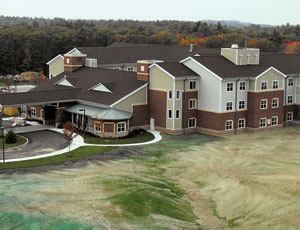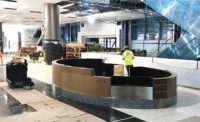Hospital and health-care owners around the nation, midway into capital construction programs that were envisioned and budgeted in less-dour economic times, are nervously watching Wall Streets woes as they race to meet growing demand for high-performance, patient-friendly, rapidly delivered facilities. Industry analysts forecasts that earlier this year projected strong hospital starts until 2009 based on unprecedented demand, reversed course by fall when owners began to balk at new plans and projects as stock markets tanked and bond rates soared.


Health-care project owners this year expected challenges such as record-high materials costs, limited labor availability, and changing market demands. But the global financial crisis has trumped those concerns, as rising bond rates hit some owners hard. Projects contingent on variable-interest hospital bonds were particularly affected because those rates have exploded, throwing an unforeseen crisis at many construction programs, says Jim Connelly, chief financial officer at Henry Ford Health System, Detroit. Its variable-rate bonds rose 6% in September due to the “unprecedented catastrophe in the credit market,” says Connelly. Ford is midway into a $360-million facility project in West Bloomfield, Mich., financed in part through adjustable-rate bonds, which could expand the budget by $20 million.
Industry analysts already see signs of dramatic cuts to health-care project starts heading into 2009 as capital dries up. Owners expect a slowdown and capital-intensive health-care markets “will not be immune to the crisis,” says Ralph Lawson, chief financial officer at Coral Gables, Fla.-based Baptist Health South Florida. Some owners will sideline or cut aspects of projects and others will scale back whole programs, he says.
Still, the growing population is spawning an unprecedented demand for new hospitals, clinics, nursing homes and research facilities. And there is a voracious market for retrofits as new technology hits the market. While the storm of economic uncertainty rages, many remain confident about the market’s long-term prospects.
At Baylor College of Medicine, Houston, officials focused on staging to keep projects moving in its program to build a $600-million 1.2-million-sq-ft hospital; a $60-million 166,000-sq-ft medical office building; and a $100-million 200,000-sq-ft medical library. “We had to strategize how we position packages and we have had to lock in prices earlier,” says Bob McCleskey, vice president of strategic capital projects at Baylor College of Medicine. “Everyone is having budget challenges.”
Owners of Laconia, N.H.-based LRGHealthcare locked in interest rates on its $37-million construction program before the financial meltdown, says Henry Lipman, the firm’s senior vice-president and chief financial officer. The project to construct new patient rooms and physician space was designed in stages with economics in mind. “We have planned the project to have different decision points so we can react to changes,” says Lipman.
For Catonsville, Md.-based Erikson Retirement Communities, which builds and operates health-care-integrated retirement communities with independent living units, skilled-care units and fully staffed medical centers, there could be a “potential upside” to the economic downturn, says Ben Tyrell, executive director at Erickson. “As home prices drop, people may begin to see an investment in a retirement-community unit as a wise move,” Tyrell says.
There are several construction projects planned at twelve of Erikson’s 23 communities. Erickson self-performs the design and construction. Among projects currently under way is a $22-million, 133-bed skilled nursing facility in Hingham, Mass., which Tyrell says is designed as a prototype to integrate high-technology while...



Post a comment to this article
Report Abusive Comment